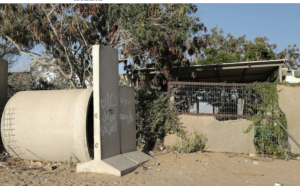‘We’re waiting for death’: Israel’s Bedouin still have no protection against Iran’s drones

An improvised shelter in the village of Bir Hadaj in southern Israel, August 2024
Eden Solomon reports in Haaretz on 6 August 2024:
The only Israeli who was hurt in the Iranian attack on Israel in April was seven-year-old Amina al-Hassouni from the unrecognized village of Al-Fura in the Negev. She was seriously wounded by an interceptor rocket that struck her home.
Since then, Amina, who is being treated in the rehabilitation ward at Tel Hashomer Hospital, has been improving, but the condition of the Bedouin villages in the Negev remains the same: They have a severe shortage of protected spaces, placing the residents in danger once more as another Iranian attack looms.
Early on Sunday evening, Amina’s family traveled to one of the wadis on the way to the Dead Sea to spend the night there. “We heard that the Iranian attack was expected, so we went to sleep in the wadi,” says Mohammed, Amina’s father. Even though after Amina was wounded, a shelter was donated to the family and installed next to their house, her siblings, who are still highly traumatized by what happened, pleaded with their father to leave the house. “They are afraid because of what happened to their sister. I told them to sleep in the shelter, but they refuse,” he says.
Hours before the Iranian attack in April, residents of Bedouin villages, especially those living in unrecognized villages, began fleeing their homes in search of shelter – under bridges, in wadis and in schools that have some protective reinforcement.
In Bir Hadaj, a recognized but unregulated village, there was chaos. Most of the homes there are made of tin, and the entire village has only three protected spaces: a small shelter next to the mosque, another one at the health clinic that was closed at the time, and one at the school. Shortly before the attack, the head of the local emergency team broke open the school doors so that residents could take shelter there. When the drone launches began, hundreds of families fled there to spend the night.
When asked how he was preparing for the anticipated Iranian attack and what instructions he has giving residents, Bir Hadaj emergency team member Mohammed al-Gadifi replies sadly: “Just to pray, that’s about all we can do.” During the attack in April, he took his wife and children to the closest school, which he said was completely jam-packed with people.
“People were clutching the walls, in terrible stress. If a missile would have fallen there, it would have been a huge disaster. There were hundreds of people crowded inside,” he says. Now, he and his family don’t know what to do to prepare for the supposedly imminent attack. “We’re basically waiting for death. In the end, there will be a major disaster here. We want the authorities to at least put up a few small shelters in each neighborhood.”
On Sunday, the community’s emergency team and local committee chairman formally requested to open the village’s four schools which contain protected spaces. On Monday, only two were opened. One is the Al-Miyan elementary school, which is undergoing renovations. A large construction waste container stands at the entrance and ladders fill the halls.
Ahmed Abu Habak, a member of the local emergency team, says he doesn’t know how people are supposed to find shelter there in the event of an attack. “In April, about 250 people came in here, [but they] weren’t protected because the shelters were completely packed. Now there’s also renovations, so that’s another problem,” he says, adding, “we made dozens of requests for shelters and were told there was no budget for it.”
As to what instructions he was given by the Home Front Command, he laughs and says: “We were told to lay on the floor and put our hands over our heads.”
And yet, residents of Bir Hadaj say that the biggest threat on their minds isn’t the attack from Iran, but that of their homes being demolished by the Israeli government. “I’m not doing anything to prepare for the attack, that’s not what I’m worried about right now,” says one. “My home was demolished the other day and now I’m living under an open shed that I built. They took the most basic thing from me, and you’re talking to me about protection?”
The conversation takes place next to a large concrete cylinder with two large blocs of concrete at either end, which was erected by the government to serve as protection from rockets. “You’ll never see something like this in a Jewish area,” says villager Salem Abu Asa. He, too, says that what worries him most is the ongoing demolition of houses in the Bedouin areas in the Negev, which has been gaining speed under National Security Minister Itamar Ben-Gvir. “When you take away from us the most basic thing there is, nothing is scary anymore, not even missiles,” he says.
The Israel Defense Forces said in response: “The Home Front command is in ongoing contact with the local mayors, the Social Equality Ministry and the Bedouin administration. Since the start of the war, the Home Front Command has been working to install protective shelters in the Bedouin areas and is leading a pilot for a type of shelter called Hesco which is composed of an American system of fortifications using steel nets and burlap filled with sand. This is a system that provides quick, effective and temporary shelter for the residents of the unincorporated Bedouin communities in the Negev. To date, more than 30 of these types of shelters have been installed.”
This article is reproduced in its entirety
